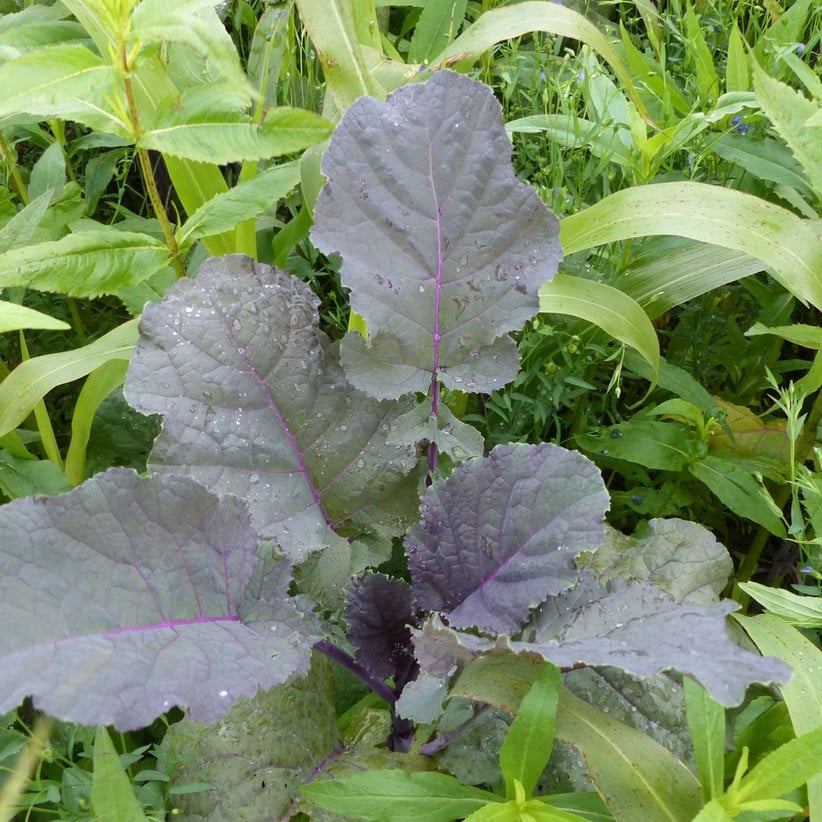Abessinischer Kohl / Äthiopischer Senf Standardsorte

Variety
Abessinischer Kohl / Äthiopischer Senf Standardsorte
Approved Data
created by Alex&Sempi at 16.11.2025
Features
Location
planting: bed
planting: outdoor
planting: raised bed
planting: near compost
light: sunny to semi-shady
Soil: permeable soil
soil moisture: no waterlogging
biotope: mountain area
Planting: mounds / ridges
Fertilization: single dose of compost
Fertilization: nutrient-rich
fertilization: humus-enriched
Soil: Well fertilized
soil moisture: fresh to moist
planting: polytunnel / under protective covers
light: Full sun
soil moisture: well-drained
Water: regularly
Soil: deep
Fertilization: phosphate-rich
Soil: light to medium-heavy
planting: open balcony or terrace
Soil: sandy to loamy
Wind: windverträglich
Soil: loosened
fertilization: potassium-rich
Water: Adequate
pH value: neutral to alkaline (7-8)
Planting: pots, tubs, or boxes
Light: Sun
fertilization: sufficient
Water: moderately
Fertilization: nitrogen-rich
Fertilization: organic
biotope: meadow / park
Heat requirement: moderate
Düngung: kalktolerant
Biotop: Feld
Pflanzung: Bauerngarten
Düngung: Langzeitdünger
Düngung: NPK 10/10/10
Düngung: NPK 12/8/16
Düngemittel: Hornspäne
Good companions: moisture-loving
Nachbarn schlechte: Schattenpflanzen
Good companions: sun-loving
Nachbarn schlechte: stark wuchernd
Nachbarn schlechte: hoher nährstoffbedarf
Nachbarn gute: mit niedrigen Nährstoffbedarf
Nachbarn schlechte: hochwachsend
Nachbarn gute: niedrigwachsend
Pflanztechnik: Mulchen
Herkunft: Neophyt
Pflanzung: Hügelbeet
Düngemittel: Mist, Dung
Growth habit
lifespan: annual
growth habit: high
harvest: profitable
harvest: continuously pickable
growth habit: stable
flower: flowering
root type: taproot
self-fruiting
strong leaves
fast growth
strong lateral shoot development
warm germination
cross-pollination
seed-fixed: yes
growth habit: upright-bushy
self-seeding
medium to strong growth
serrated leaves
leaves: leafy
wide: 20 - 30 cm
height: 120 - 140 cm
growth habit: well-branched
hermaphroditic
growth habit: upright flower stems
lobed leaves
simple flower
small flowers
large leaves
non-woody
propagation by seeds
perennial
insect pollination
Blütenstand: traubenförmig
Geschlechtertyp: einhäusig
Keimung: Dunkelkeimer
Blüte: duftend schwach
Wuchs: nicht invasiv
Blätter: einfach
Blätter: oval
Blätter: länglich
Blütenform: kreuzförmig
Blätter: gewellt
Fruit shape
elongated
pod
medium-sized
Resistances
robust
drought tolerant
heat resistant
frost-sensitive
Color
light green / pale green
medium green
Black seeded
Flower yellow
Fruit: yellow-green
Blattrippen: weiß
Blätter: blaugrün
Frucht: braungrün/grünbraun
Frucht: grün
Farbe: einfarbig
Stamm, Stiel: grün
Oberfläche: wachsig
Oberfläche: schimmernd
Wurzel: weiß
Blattrippen: gelb
Blattrippen: grün
Samen: braun
Wurzel: beige
Herbstfärbung: keine
Taste
Slightly bitter
mustard aroma
Slightly spicy
intensive
savory
Slightly savory
raw edible
Edible
juicy
tender
slightly nutty
cabbage flavor
Essbarkeit: Blätter
Essbarkeit: Samen
Toxizität: ungiftig
Konsistenz: faserig
Cultivation Break
4 Years
Season Overview
Propagating
Planting
Harvest
J
F
M
A
M
J
J
A
S
O
N
D
Description
Brassica carinata is a plant species from the cruciferous family (Brassicaceae). It is also known by the common names Ethiopian rape or Ethiopian mustard. It is thought to be a hybrid between Brassica nigra and Brassica oleracea. Representatives of the Brassica carinata species were cultivated in Ethiopia as early as the 4th millennium BC. Traditionally, the leaves and young shoots are used as vegetables and the seeds for the production of a type of mustard or for oil production. The plant has a mild taste and is eaten as a leafy vegetable. It is known as (Oromo : Raafuu); habesha gomen (Amharic : ሐበሻ ጎመን). One of the varieties is Texsel, which is particularly well adapted to temperate climates. The cultivation of Ethiopian mustard as a leafy vegetable is currently limited to small-scale production, but is slowly gaining popularity in both rural and urban areas where commercial cultivation takes place. Although Brassica carinata is grown as an oil crop in Ethiopia, it has high levels of undesirable glucosinolates and erucic acid (40-45%). The closely related species Brassica napus (rapeseed) is considered a better oil plant in comparison. Brassica carinata was used to develop a biofuel for aircraft engines. On October 29, 2012, the first flight of an aircraft powered entirely by biofuel from Brassica carinata took place. The by-product of Brassica carinata oil production is used in protein feed for animals. It is also suitable for the production of plastics, lubricants, paints, leather tanning, soaps and cosmetics.
Non hybrid
Not frost resistant
Growing tips
The climate in Ethiopia is largely temperate, but there are also longer periods of drought every year. The Abyssinian cabbage is well adapted to both, which is why it thrives well in our latitudes and also copes well with unfavorable conditions such as heat and drought. It only tolerates frost to a limited extent.
Details
Light requirement
Sunny
Water requirement
Moist
Soil
Medium (loamy)
Nutrient requirement
Medium
Dark germinator
Germination temperature
15 - 20 °C (Degrees Celsius)
Plant distance
5 cm
Row spacing
25 cm
Seeding depth
1 cm
Companion Plants
Bean (Dwarf bean)
Bean (Runner bean)
Celery (Celeriac / Celery root)
Celery (Celery)
Celery (Leaf celery / Chinese celery)
Chives
Garlic
Lettuce (Common chicory)
Lettuce (Endive / Escarole / Erisée)
Lettuce (Lamb's lettuce)
Lettuce (Lettuce)
Lettuce (Oriental greens / Brown mustard)
Lettuce (Puntarelle / Cicoria di catalogna / Cicoria asparago)
Lettuce (Radicchio / Italian chicory)
Lettuce (Sugar loaf)
Onion
Onion (Spring onion)
Potato
Spinach (Summer)
Spinach (Winter)
Antagonistic Plants
Aubergine / Eggplant
Broccoli
Broccoli raab / Stem cabbage / Cima di rapa
Brussels sprouts
Cabbage (Cabbage)
Cabbage (Pointed cabbage)
Cabbage (red cabbage)
Cabbage (Savoy cabbage)
Cauliflower
Chili
Collard greens
Collard greens (Kale)
Collard greens (Tuscan kale / Dinosaur kale / Palm tree kale)
Corn / Maize
Courgette / Zucchini
Cucumber / Gherkin
Gemüsekohl - Flower Sprouts / Kohlröschen
Gemüsekohl - Futterkohl
Gemüsekohl - Kai-Lan / Chinesischer Brokkoli
Gemüsekohl - Rippenkohl / Portugiesischer Kohl
Gemüsekohl - Wildkohl / Urkohl
Kohlrabi / German turnip / Turnip cabbage
Mustard
Napa cabbage / Chinese cabbage
Okra
Pepper / Paprika
Radish
Radishes
Raps - Scheerkohl / Sibirischer Kohl
Strawberry
Tomato (Bush tomato)
Tomato (Cocktail bush tomato)
Tomato (Cocktail Stake Tomato)
Tomato (Stake tomato)
Diseases
Root Rot
Black spot of roses
Club root of cabbage
Grey mold
Powdery mildews
Pests
Land snails
Caterpillars
Cabbage white
Cabbage fly
Cabbage heart midge
Flea beetles
Aphids